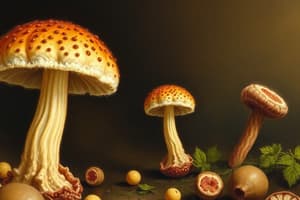Podcast
Questions and Answers
What is the mode of transmission for Tetanus?
What is the mode of transmission for Tetanus?
- Consumption of contaminated food or water
- Airborne transmission through respiratory droplets
- Contamination of deep wound with spore-containing dust or soil (correct)
- Transmission through direct contact with infected individuals
Which Clostridium species causes Gas Gangrene?
Which Clostridium species causes Gas Gangrene?
- Clostridium difficile
- Clostridium tetani
- Clostridium botulinum
- Clostridium perfringens (correct)
What is the characteristic morphology of Clostridium tetani?
What is the characteristic morphology of Clostridium tetani?
- Gram-negative spherical bacteria with flagella
- Gram-positive bacilli swollen at one end with terminal spores (correct)
- Gram-positive rods forming long chains
- Gram-variable cocci in clusters
Which Clostridium species causes botulism?
Which Clostridium species causes botulism?
What is the typical habitat for most members of the Clostridium genus?
What is the typical habitat for most members of the Clostridium genus?
Flashcards are hidden until you start studying
Study Notes
Clostridium Transmission and Morphology
- Tetanus is transmitted through wounds contaminated with spores of Clostridium tetani.
- Clostridium perfringens causes Gas Gangrene.
Clostridium Characteristics
- Clostridium tetani has a characteristic drumstick morphology, with a terminal spore.
Clostridium-Related Diseases
- Clostridium botulinum causes botulism.
Clostridium Habitat
- Most members of the Clostridium genus are typically found in soil and the gastrointestinal tract of animals.
Studying That Suits You
Use AI to generate personalized quizzes and flashcards to suit your learning preferences.



